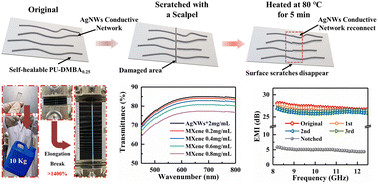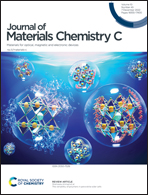Robust, transparent, and conductive AgNW/MXene composite polyurethane self-healing film for electromagnetic interference shielding†
Abstract
Electromagnetic interference (EMI) pollution poses risks to electronic devices and human health and has emerged as a major source of pollution. In addition to being low in weight and exhibiting high transparency, flexibility, and easy processability, the polymer-based transparent conductive films (TCFs) increasingly used for EMI shielding exhibit fragility, and scratches in TCFs during service usually cause severe electromagnetic wave leakage and waste. To address this issue, we designed a DMBA-modified oxime-carbamate polyurethane film with remarkable mechanical strength, high transmittance, and self-healing efficiency and prepared TCFs by uniformly depositing AgNWs and Ti3C2Tx MXene on the material surface. The TCFs show an ultra-low sheet resistance (18 Ω sq−1), high transmittance (82.8%), good EMI shielding effectiveness (SE, 27.1 dB), and excellent retention of properties after 1000 flexures and rapid recovery after three cutoff/self-repair cycles, demonstrating resistance against damage. The novel TCFs exhibit great potential for application in consumer electronics, radio communications, and radar stealth.



 Please wait while we load your content...
Please wait while we load your content...